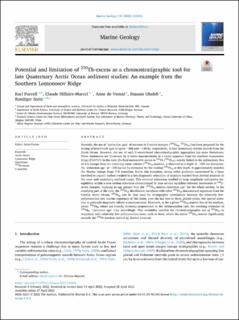| dc.description.abstract | Recently, the use of “extinction ages” of excesses in U-series isotopes (230Thxs, 231Paxs) has been proposed for the setting of benchmark ages of up to ~350 and ~150 ka, respectively, in late Quaternary marine records from the Arctic Ocean. However, the use of such U-series-based chronostratigraphic approaches has some limitations. These limitations are illustrated by U-series measurements in a cored sequence from the southern Lomonosov Ridge (PS2757). In this core, the final measurable excess in 230Th (230Thxs), strictly linked to the sedimentary flux of this isotope from the overlying water column (230Thxs-marine), is observed at a depth of ~590 cm downcore. An “extinction age” of ~230 ka can be estimated for the residual 230Thxs at this depth. It approximately matches the Marine Isotope Stage 7/8 transition. Below this transition, strong redox gradients constrained by a layer enriched in organic carbon resulted in a late-diagenetic relocation of uranium leached from detrital minerals in the over- and underlying oxidized layers. This uranium relocation resulted in large amplitude radioactive disequilibria within a core section otherwise characterized by near secular equilibria between inventories of 238U-series isotopes, implying an age greater than the “230Thxs-marine extinction age” for the whole section. In the overlying part of the core, the 230Thxs distribution correlates with other 230Thxs-documented sequences from the Central Arctic Ocean. 230Thxs can be thus used for stratigraphic correlations between the relatively low-sedimentation rate marine sequences of this basin, over the last two or three glacial cycles, but special attention to potential diagenetic effects is recommended. Moreover, as for a given 230Thxs-marine flux at the seafloor, initial 230Thxs-values are broadly inversely-proportional to the sedimentation rate, the resulting estimates of 230Thxs “extinction age” vary accordingly. This variability restricts the chronostratigraphic use of 230Thxs to sequences with relatively low sedimentation rates, such as those where the initial 230Thxs-marine significantly exceeds the 230Th-fraction carried by detrital minerals. | en_US |

